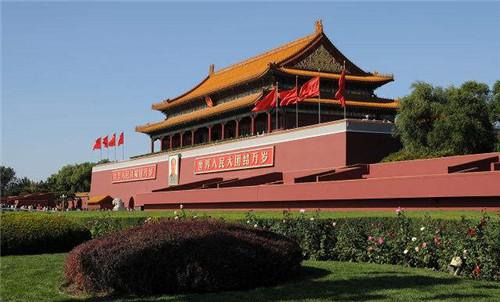Tiananmen, formerly known as "Chengtianmen", is located in the heart of Beijing and has been a witness to major events in history since the Ming Dynasty's Yongle was built in 15 years. At the same time, Tiananmen, as the symbol of China, has always had a supreme position in people's hearts.

According to historical records, the designer of Tiananmen Square was the famous Ming Dynasty architect Qu Xiang, and his father Ku Fu was also a skilled teacher who was once the "carpenter" who was in charge of building the imperial palace. After his father returned to his hometown, Ku Xiang learned all the skills of his father, improved them, and gradually emerged in the field of architecture, and finally was able to inherit his father's business, take over his father's previous position, and continue to serve as the "carpentry chief" in the palace.
In 1417, Ming Chengzu moved north from Jinling with the intention of building an imperial palace in Beijing. So he ordered the gathering of famous craftsmen from all over the country to Beijing to participate in the construction of the new imperial palace. As the "head of carpentry", Ku Xiang was naturally given the position of chief designer by the emperor, and in order to live up to the holy grace, Ku Xiang read a large number of architectural atlases, constantly improved the design drawings, and collected the strengths of hundreds of families, and finally successfully built the "Chengtian Gate" in 1421, which was unanimously praised by the emperor and the Manchu Dynasty Wenwu.
However, the original Tiananmen Square is not what it is now. At the end of the Ming Dynasty, the Chengtian gate was destroyed by fire, and Ku Xiang once again participated in the construction of Tiananmen Square. In 1651, the construction of the new Chengtianmen Gate was completed, which is the 33.7 meters, 9 wide and 5 deep Tiananmen Square that we see today. In Tiananmen, there were many memorable events: in 1911, the feudal monarchy that ruled China for thousands of years was declared to end here; the "May Fourth Movement" in 1919 broke out here; and the founding ceremony of the People's Republic of China in 1949 was also held here.
After hundreds of years of ups and downs, the walls of Tiananmen Square have been dilapidated, and the building has cracked and dissimilarized in many places. In order to solve this problem, the state decided after research to frequently renovate and build the damaged parts of Tiananmen Square, including the installation of lightning protection facilities and the reinforcement of handrails and stairs. Until 1969, Tiananmen had reached the point where it could not be renovated, and the only way to solve the "problems left over from history" at one time was to rebuild Tiananmen.
Unexpectedly, just as a construction worker was about to tear down the glazed tiles of the roof, he saw a different tile, and he was confused and planned to uncover the tiles to find out. It turned out that there was a wooden box under the tile, and he stared at the old wooden box, and his heart was suddenly excited, and his face looked unusually rosy because of excitement. However, the remaining reason told him that this matter was of great significance and must be reported to the leadership.
As soon as the news was transmitted, the cultural relics department immediately rushed to the scene for inspection, and the experts took a closer look and found that the material of the wooden box was actually gold silk nan wood. When the box is opened, the contents are not rare treasures, but grains such as soybeans, sorghum rice, black beans, and a huge ruby and some cinnabar. In this regard, experts have made a detailed explanation, during the Ming and Qing dynasties, the emperor usually offered five grains, that is, "five colored grains" when offering sacrifices to the heavens, in order to pray for the safety of the country and the people, the wind and rain were smooth, and the emperor would send people to put the grains in a wooden box and hide them under the tiles of the city tower, which was a beautiful prayer.